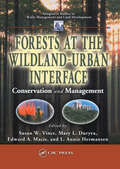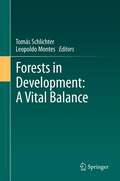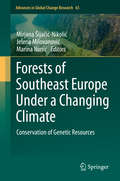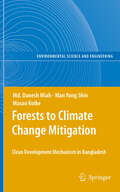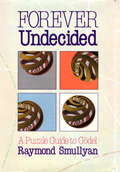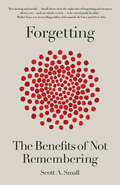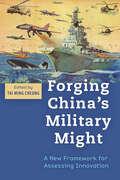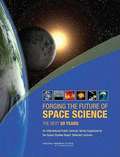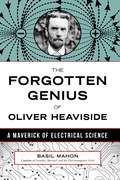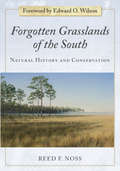- Table View
- List View
Forests as Complex Social and Ecological Systems: A Festschrift for Chadwick D. Oliver (Managing Forest Ecosystems #41)
by Patrick J. Baker David R. Larsen Alark SaxenaProfessor Chadwick Dearing Oliver has made major intellectual contributions to forest science and natural resources management. Over the course of his career he has actively sought to bring research and practice together through synthesis, outreach, and capacity-building. A common thread throughout his career has been complexity and how we as a society understand and manage complex systems. His work on forest stand dynamics, landscape management, and sustainability have all focused on the emergent properties of complex ecological and/or social systems. This volume celebrates a remarkable career through a diverse group of former students and colleagues who work on a wide range of subject areas related to the management of complex natural resource systems. Over the past decade there has been considerable discussion about forests as complex adaptive systems. Advances in remote sensing, social methods, and data collection and processing have enabled more detailed characterisations of complex natural systems across spatial and temporal scales than ever before. Making sense of these data, however, requires conceptual frameworks that are robust to the complexity of the systems and their inherent dynamics, particularly in the context of global change. This volume presents a collection of cutting-edge research on natural ecosystems and their dynamics through the lens of complex adaptive systems. It includes contributions by a wide range of authors from academia, NGOs, forest industry, and governmental organisations with diverse perspectives on forests and natural resources management. Each chapter offers new insights into how these systems can be made more resilient to ensure that they provide a diversity of ecological and social values well into the future. Together they provide a robust way of thinking about the many challenges that natural ecosystems face and how we as society may best address them.
Forests at Risk: Climate Change and the Future of the American West
by Aspen Center for Environmental StudiesClimate change poses a huge threat to the West. The currmountain pine beetle epidemic with over 50 million acres of dying trees in western North America has created a powerful “teachable moment” across the region. A primary goal of the Forests At Risk symposium was to reframe the nation’s climate change dialogue by making the issue both personal and real to many who may not appreciate its connection to the immediate world around them. While some may have difficulty relating to rising sea levels, falling water tables, imperiled polar bears and melting glaciers in far-off places, they are still shocked by the sight of vast dying forests around their homes. The Forests At Risk symposium explored the statemby Andy Jacobson, a carbon cycle scientist at the National Oceanic and Atmospheric Administration in Boulder, that “this is the kind of feedback we're all very worried about in the carbon cycle ... a warming planet leading to, in this case, an insect outbreak that increases carbon dioxide into the atmosphere, which can increase warming.” The overwhelming scientific consensus holds that climate change is one of the mserious threats facing humankind today. We have a soberingly short time in which to reduce atmospheric greenhouse gases if we are to preserve our quality of life and environment. In addition to the global urgency, the American West is deeply dependon the health of its forests, mountains and streams for both its quality of life and its economy. Put simply, if global warming shortens our winters, diminishes our recreation, and unleashes wildfires, diseases and insect epidemics that devastate our forests, the regional damage would be incalculable. NOW is the perfect time to learn more in this ebook. The Forests At Risk symposium represented the first substantial public forum focused directly on the connection between climate change and forest health in the American West. In the wake of millions of acres of pine beetle devastation across our continent, this is the ideal momto highlight the climate change connection and focus on the question of what happens when our forests transform from carbon sinks into carbon sources.
Forests at the Wildland-Urban Interface: Conservation and Management (Integrative Studies in Water Management & Land Development)
by Mary L. Duryea Susan W. Vince Edward A. Macie L. Annie HermansenForests at the wildland-urban interface are at increasing risk due to the impacts of urbanization. Conserving and managing these forestlands for continued ecological and social benefits is a critical and complex challenge facing natural resource managers, land-use planners, and policymakers.Forests at the Wildland-Urban Interface: Conservat
Forests for the People: The Story of America's Eastern National Forests
by Christopher Johnson David GovatskiAt the turn of the twentieth century, widespread clearcutting resulted in ecological ruin and devastating fires in America's Eastern forests. A coalition of citizens, organizations, and business and political leaders fought against this pattern, and in 1911, they achieved a landmark victory with the Weeks Act, which protected millions of acres of Eastern forests. Forests for the People tells the fascinating story of this vital legislation and the citizens and organizations that made it a reality. While these protected forests survive today, many of the critical issues facing American forests in the twentieth century persist, and new threats have arisen--including oil shale drilling, invasive species, and development around national parks. In Forests for the People, Christopher Johnson and David Govatski draw upon the lessons and victories of the past to examine the vital issues facing American forests today and illuminate paths to better forest management.
Forests in Development: A Vital Balance
by Tomás Schlichter Leopoldo MontesForests in Development: A Vital Balance, shows some of the main advances in forestry over the six years spanning between the XII World Forestry Congress in Canada and the XIII WFC held in Buenos Aires. The book covers most of the themes of the XIII WFC, from biodiversity through production, policies, environmental services, and economic aspects, linked by sustainability. It provides a comprehensive view of forestry today, conveying its different aspects through one solid piece addressed by authors whose work denotes a concept of sustainable forest management which is not so much a puzzle laboriously put together as a many-faced unity, steered to achieve ultimately a better quality of living for present and future generations.
Forests in Our Changing World: New Principles for Conservation and Management
by Richard Waring Joe LandsbergScientists tell us that climate change is upon us and the physical world is changing quickly with important implications for biodiversity and human well-being. Forests cover vast regions of the globe and serve as a first line of defense against the worst effects of climate change, but only if we keep them healthy and resilient. Forests in Our Changing Worldtells us how to do that. Authors Joe Landsberg and Richard Waring present an overview of forests around the globe, describing basic precepts of forest ecology and physiology and how forests will change as earth's climate warms. Drawing on years of research and teaching, they discuss the values and uses of both natural and plantation-based forests. In easy-to-understand terms, they describe the ecosystem services forests provide, such as clean water and wildlife habitat, present economic concepts important to the management and policy decisions that affect forests, and introduce the use of growth-and-yield models and remote-sensing technology that provide the data behind those decisions. This book is a useful guide for undergraduates as well as managers, administrators, and policy makers in environmental organizations and government agencies looking for a clear overview of basic forest processes and pragmatic suggestions for protecting the health of forests.
Forests in Time: The Environmental Consequences of 1,000 Years of Change in New England
by John D. Aber David R. FosterThis important book relates the history of natural and human-induced changes that have occurred in the past one thousand years in New England and explores the modern ecology of this largely forested landscape. Written by leading biological, physical, and social scientists, the book uniquely demonstrates that an understanding of landscape history is essential for the study of ecology and environmental management.
Forests of Refuge: Decolonizing Environmental Governance in the Amazonian Guiana Shield
by Dr. Yolanda Ariadne CollinsForests of Refuge questions the effectiveness of market-based policies that govern forests in the interest of mitigating climate change. Yolanda Ariadne Collins interrogates the most ambitious global plan to incentivize people away from deforesting activities: the United Nations–endorsed Reducing Emissions from Deforestation and Forest Degradation (REDD+) initiative. Forests of Refuge explores REDD+ in Guyana and neighboring Suriname, two highly forested countries in the Amazonian Guiana Shield with low deforestation rates. Yet REDD+ implementation there has been fraught with challenges. Adopting a multisited ethnographic approach, Forests of Refuge takes readers into the halls of policymaking, into conservation development organizations, and into forest-dependent communities most affected by environmental policies and exploitative colonial histories. This book situates these challenges in the inattentiveness of global environmental policies to roughly five hundred years of colonial histories that positioned the forests as places of refuge and resistance. It advocates that the fruits of these oppressive histories be reckoned with through processes of decolonization.
Forests of Southeast Europe Under a Changing Climate: Conservation of Genetic Resources (Advances in Global Change Research #65)
by Mirjana Šijačić-Nikolić Jelena Milovanović Marina NonićThis book integrates the different prospective, scientific and practical experience of researchers as well as beneficiaries and stakeholders in the field of forest conservation in Southeast Europe. The book stresses the importance of improving the adaptability of these ecosystems to the impacts of climate change. Gathered around a common idea, the book presents the latest results in forest genetic resources conservation at national and regional level. The chapters are written by experts from: Bosnia and Herzegovina, Bulgaria, Croatia, FYR Macedonia, Greece, Montenegro, Romania, Serbia and Slovenia. The book presents the current state, legal and institutional framework for conservation and management of forest genetic resources, case studies and best practices in the application of different conservation methods and techniques (in situ and ex situ) as well as climate change aspects in this area. This book will be of particular interest to scientists and experts in the field of forestry, environmental protection and rural development, bachelor, master and doctoral students, as well as for anyone interested in the conservation issues fuelled by ethical and economic motives.
Forests of the Southern Appalachian Highlands and Interior Highlands of the United States (Plant and Vegetation #20)
by Steven L. Stephenson Rose-Marie MuzikaSpanning millennia of history and ecological transformation, this book explores the forested and non-forested ecosystems of the Southern Appalachians and Interior Highlands regions of the United States. It examines their fauna and flora, highlighting both shared and regionally distinct species. The volume provides a comprehensive treatment of the terrestrial biota, with chapters devoted to forest composition, vegetation structure, and fungal diversity. Additional chapters focus on the vertebrate and invertebrate fauna of the Appalachians and Ozarks, including mammals, birds, reptiles, amphibians, insects, and non-insect arthropods. Beyond taxonomy and ecology, the authors investigate the historical and contemporary forces that have shaped these landscapes—from the Woodland Period and European colonization to industrial exploitation and modern conservation efforts. Particular attention is given to the ecological impacts of logging, mining, invasive pathogens, and climate change, as well as to the resilience and vulnerability of these ecosystems. Rich in detail and imagery, and grounded in scientific rigor, this volume is an essential resource for ecologists, conservation biologists, forest managers, and anyone seeking a deeper understanding of the ecological heritage and future of these two mountain regions.
Forests to Climate Change Mitigation
by Man Yong Shin Masao Koike Md. Danesh MiahToday, the effect of global climate change is clear to all. It is clearly dangerous in developing countries such as Bangladesh. The industrial revolution caused major changes in technology, socio-economy and cultures in the late 18th and early 19th century, beginning in Britain and spreading throughout the world. The technology dominated economy was mostly dependent on energy produced from fossil fuel, which still holds true today. It is well known that fossil fuel burning has increased the GHGs to the atmosphere, thus creating global warming. Among the GHGs, the concentration of CO2 has been confirmed as the largest. Terrestrial ecosystems are clearly influencing the concentration of GHGs in the atmosphere. Greenhouse gases are constantly entering and leaving the atmosphere. Actively growing trees and other plants absorb CO2 from the atmosphere, combine it with water through photosynthesis and create sugars and more stable carbohydrates. Through this process, trees capture and store atmospheric CO2 in vegetation, soils and biomass products. The Kyoto Protocol, in 1997, explored a flexible mechanism, CDM (Clean Development Mechanism) where Annex I and non-Annex I parties interact for climate change mitigation. Forestry activities have been considered important in the arena of climate change as they act both as a sink and sources of carbon. The purpose of this book is to highlight the means of efficiently reducing global warming through forestry options in Bangladesh and the positive implications of CDM.
Forests: The Shadow of Civilization
by Robert Pogue HarrisonIn this wide-ranging exploration of the role of forests in Western thought, Robert Pogue Harrison enriches our understanding not only of the forest's place in the cultural imagination of the West, but also of the ecological dilemmas that now confront us so urgently. Consistently insightful and beautifully written, this work is especially compelling at a time when the forest, as a source of wonder, respect, and meaning, disappears daily from the earth. "Forests is one of the most remarkable essays on the human place in nature I have ever read, and belongs on the small shelf that includes Raymond Williams' masterpiece, The Country and the City. Elegantly conceived, beautifully written, and powerfully argued, [Forests] is a model of scholarship at its passionate best. No one who cares about cultural history, about the human place in nature, or about the future of our earthly home, should miss it.—William Cronon, Yale Review "Forests is, among other things, a work of scholarship, and one of immense value . . . one that we have needed. It can be read and reread, added to and commented on for some time to come."—John Haines, The New York Times Book Review
Forever Begins Tomorrow (The A.I. Gang #3)
by Bruce CovilleCan the gang save the world before it's too late? When it comes down to adults versus kids, who's going to believe the kids--even if they are geniuses? That's the problem the A.I. Gang faces when they find themselves locked in a death-defying final showdown with the mysterious Black Glove. Contending with danger and disgrace, the team fights on with only the help of a mysterious friend to give them an occasional clue. But these six kids just can't give up. Would you, if you were the only thing standing in the way of a high-tech horror that could spell destruction for the entire planet? This ebook features an illustrated personal history of Bruce Coville including rare images from the author's collection.
Forever Free
by Joy AdamsonThe third book (after Born Free and Living Free) of the most beloved animal story of our time, about Elsa the lion.
Forever Ours: Real Stories of Immortality and Living from a Forensic Pathologist
by Janis Amatuzio[From the Book Jacket] As a physician, forensic pathologist, and coroner for several Minnesota counties, I have had the extraordinary privilege of caring for families and their loved ones when death comes suddenly, unexpectedly, or traumatically. My job is to speak for the dead, to solve the mystery of "What happened?" However, I have occasionally been faced with mysteries I cannot solve or explain. These experiences always baffle me, partly because as a scientist I seek to reach a reasonable degree of medical certainty, a rational explanation. But I have come to realize that for some experiences there is no explanation, just a deep knowing that I have encountered the Divine. - JANIS AMATUZIO, MD
Forever Undecided
by Raymond M. SmullyanForever Undecided is the most challenging yet of Raymond Smullyan's puzzle collections. It is, at the same time, an introduction--ingenious, instructive, entertaining--to Gödel's famous theorems. With all the wit and charm that have delighted readers of his previous books, Smullyan transports us once again to that magical island where knights always tell the truth and knaves always lie. Here we meet a new and amazing array of characters, visitors to the island, seeking to determine the natives' identities. Among them: the census-taker McGregor; a philosophical-logician in search of his flighty bird-wife, Oona; and a regiment of Reasoners (timid ones, normal ones, conceited, modest, and peculiar ones) armed with the rules of propositional logic (if X is true, then so is Y). By following the Reasoners through brain-tingling exercises and adventures--including journeys into the "other possible worlds" of Kripke semantics--even the most illogical of us come to understand Gödel's two great theorems on incompleteness and undecidability, some of their philosophical and mathematical implications, and why we, like Gödel himself, must remain Forever Undecided!
Forever Young: A Life of Adventure in Air and Space
by John W YoungHe walked on the Moon. He flew six space missions in three different programs--more than any other human. He served with NASA for more than four decades. His peers called him the "astronaut's astronaut."Enthusiasts of space exploration have long waited for John Young to tell the story of his two Gemini flights, his two Apollo missions, the first-ever Space Shuttle flight, and the first Spacelab mission. Forever Young delivers all that and more: Young's personal journey from engineering graduate to fighter pilot, to test pilot, to astronaut, to high NASA official, to clear-headed predictor of the fate of Planet Earth.Young, with the assistance of internationally distinguished aerospace historian James Hansen, recounts the great episodes of his amazing flying career in fascinating detail and with wry humor. He portrays astronauts as ordinary human beings and NASA as an institution with the same ups and downs as other major bureaucracies. He frankly discusses the risks of space travel, including what went wrong with the Challenger and Columbia shuttles. Forever Young is one of the last memoirs produced by an early American astronaut. It is the first memoir written by a chief of the NASA astronaut corps. Young's experiences and candor make this book indispensable to everyone interested in the U.S. space program.
Forged: An Altered Series Prequel (Altered)
by Jennifer RushBefore Anna and Sam, there was Dani and Sam.There's one rule that all Branch operatives must live by: No attachments. When Dani O'Brien entered the Branch, she planned to trade her freedom so that her family could have a better life. But joining up with the mysterious organization is more than she bargained for. Branch head Connor watches over her closely--too closely. The training is brutal, the experiments are secret, and the missions promise to be anything but ordinary. The only thing getting Dani through each day is the hope that she'll run into Sam--a young man, about her age, who wears the world on his shoulders.Find out how it all began in this short-story prequel to Jennifer Rush's thrilling and suspenseful Altered series.
Forgetting: The Benefits of Not Remembering
by Scott A. Small&“Fascinating and useful . . . The distinguished memory researcher Scott A. Small explains why forgetfulness is not only normal but also beneficial.&”—Walter Isaacson, bestselling author of Leonardo da Vinci and Steve JobsWho wouldn&’t want a better memory? Dr. Scott Small has dedicated his career to understanding why memory forsakes us. As director of the Alzheimer&’s Disease Research Center at Columbia University, he focuses largely on patients who experience pathological forgetting, and it is in contrast to their suffering that normal forgetting, which we experience every day, appears in sharp relief. Until recently, most everyone—memory scientists included—believed that forgetting served no purpose. But new research in psychology, neurobiology, medicine, and computer science tells a different story. Forgetting is not a failure of our minds. It&’s not even a benign glitch. It is, in fact, good for us—and, alongside memory, it is a required function for our minds to work best. Forgetting benefits our cognitive and creative abilities, emotional well-being, and even our personal and societal health. As frustrating as a typical lapse can be, it&’s precisely what opens up our minds to making better decisions, experiencing joy and relationships, and flourishing artistically. From studies of bonobos in the wild to visits with the iconic painter Jasper Johns and the renowned decision-making expert Daniel Kahneman, Small looks across disciplines to put new scientific findings into illuminating context while also revealing groundbreaking developments about Alzheimer&’s disease. The next time you forget where you left your keys, remember that a little forgetting does a lot of good.
Forging China's Military Might: A New Framework for Assessing Innovation
by Tai Ming Cheung“His collection of nine essays offers a comprehensive and insightful assessment of the Chinese defense science and technology (S&T).” —Pacific AffairsAmong the most important issues in international security today are the nature and the global implications of China’s emergence as a world-class defense technology power. Since the beginning of the twenty-first century, the Chinese defense industry has reinvented itself by emphasizing technological innovation and technology. This reinvention and its potential effects, both positive and negative, are attracting global scrutiny. Drawing insights from a range of disciplines, including history, social science, business, and strategic studies, Tai Ming Cheung and the contributors to Forging China’s Military Might develop an analytical framework to evaluate the nature, dimensions, and spectrum of Chinese innovation in the military and broader defense spheres.Forging China’s Military Might provides an overview of the current state of the Chinese defense industry and then focuses on subjects critical to understanding short- and long-term developments, including the relationship among defense contractors, regulators, and end-users; civil-military integration; China’s defense innovation system; and China’s place in the global defense economy. Case studies look in detail at the Chinese space and missile industry.“Constitutes high-quality, cutting-edge research on China’s defense industries. It should enjoy broad appeal—among academics, policy makers, security analysts, and business people in countries around the world.” —Andrew Scobell, RAND Corporation“Forging China’s Military Might belongs in any political science shelf interested in China’s issues and international security and considers the nature of China’s emergence as a world power.” —Midwest Book Review
Forging the Future of Space Science: The Next 50 Years
by National Research Council of the National AcademiesFrom September 2007 to June 2008 the Space Studies Board conducted an international public seminar series, with each monthly talk highlighting a different topic in space and Earth science. The principal lectures from the series are compiled in Forging the Future of Space Science. The topics of these events covered the full spectrum of space and Earth science research, from global climate change, to the cosmic origins of life, to the exploration of the Moon and Mars, to the scientific research required to support human spaceflight. The prevailing messages throughout the seminar series as demonstrated by the lectures in this book are how much we have accomplished over the past 50 years, how profound are our discoveries, how much contributions from the space program affect our daily lives, and yet how much remains to be done. The age of discovery in space and Earth science is just beginning. Opportunities abound that will forever alter our destiny.
Forgotten (FADE Series #3)
by Kailin GowWinner of the IBPA Benjamin Franklin Silver Award! PRAISE FOR FADE: "Kailin Gow does her readers justice with this thrilling and mind boggling series. Fade introduces readers to a concept that is out of this world." - Woven Myst Young Adult Magazine DESCRIPTION for FORGOTTEN (FADE BOOK 3): A love that can never be forgotten... The truth about Celestra Caine comes back in the most shocking way. Everyone knew Celestra Caine was dangerous, but they didn't know she was THAT dangerous... As Celestra's memories begin returning to her after being Faded, and her identity is revealed, she learns the fate of the world really is in her hands, and that she, the mysterious and sexy fader Jack, and her handsome ex-boyfriend Gray are more connected to each other than she ever imagined. In this dystopian ya thriller, where nothing is what it seems, sometimes love can be strong enough to withstand time and space and never be forgotten. Kailin Gow's FADE Series(TM) FADE Falling (FADE #2) Forgotten (FADE #3) Fever (FADE #4)
Forgotten Experts: Astrologers, Science, and Authority in the Ottoman Empire, 1450–1600 (Stanford Ottoman World Series: Critical Studies in Empire, Nature, and Knowledge)
by A. Tunç ŞenForgotten Experts offers a history of Ottoman court astrologers and traces their shifting authority and prestige over the long sixteenth century. These individuals served the Ottoman court with their expertise in mathematical, astronomical, and astrological sciences, distinguishing themselves from other occult practitioners and esoteric specialists. While both prophecy and prognostication are attempts to map the terrain of the future, the astrologers' work did not claim spiritual weight as a prophecy but relied instead on methods of prediction developed from data and patterns elaborated through technical and scientific writings. Drawing on extensive manuscript and archival records written in Ottoman Turkish, Persian, and Arabic, A. Tunç Şen writes a history of science, state formation, and bureaucracy within the overarching tale of Ottoman imperial formation and protocols. He invites readers to follow Ottoman court astrologers' fluctuating careers as practitioners of a contentious science and shows how this class of learned individuals constructed its scientific authority despite numerous cultural, societal, and epistemic challenges. In understanding the expertise of court astrologers, we gain insight into the intricate social relations established and maintained between the men of knowledge and the men of rule, between expertise and statecraft, in the early modern Ottoman imperial context.
Forgotten Genius of Oliver Heaviside: A Maverick of Electrical Science
by Basil MahonFINALIST! 2019 IEEE William and Joyce Middleton Electrical Engineering History AwardThis biography of Oliver Heaviside profiles the life of an underappreciated genius and describes his many contributions to electrical science, which proved to be essential to the future of mass communications. Oliver Heaviside (1850 -1925) may not be a household name but he was one of the great pioneers of electrical science: his work led to huge advances in communications and became the bedrock of the subject of electrical engineering as it is taught and practiced today. His ideas and original accomplishments are now so much a part of everyday electrical science that they are simply taken for granted; almost nobody wonders how they came about and Heaviside's name has been lost from view.This book tells the complete story of this extraordinary though often unappreciated scientist. The author interweaves details of Heaviside's life and personality with clear explanations of his many important contributions to the field of electrical engineering. He describes a man with an irreverent sense of fun who cared nothing for social or mathematical conventions and lived a fiercely independent life. His achievements include creating the mathematical tools that were to prove essential to the proper understanding and use of electricity, finding a way to rid telephone lines of the distortion that had stifled progress, and showing that electrical power doesn't flow in a wire but in the space alongside it. At first his ideas were thought to be weird, even outrageous, and he had to battle long and hard to get them accepted. Yet by the end of his life he was awarded the first Faraday Medal. This engrossing story will restore long-overdue recognition to a scientist whose achievements in many ways were as crucial to our modern age as those of Edison's and Tesla's.
Forgotten Grasslands of the South: Natural History and Conservation
by Reed F NossForgotten Grasslands of the South is the study of one of the biologically richest and most endangered ecosystems in North America. In a seamless blend of science and personal observation, renowned ecologist Reed Noss explains the natural history of southern grasslands, their origin and history, and the physical determinants of grassland distribution, including ecology, soils, landform, and hydrology. In addition to offering fascinating new information about these little-studied ecosystems, Noss demonstrates how natural history is central to the practice of conservation. Although theory and experimentation have recently dominated the field of ecology, ecologists are coming to realize how these distinct approaches are not divergent but complementary, and that pursuing them together can bring greater knowledge and understanding of how the natural world works and how we can best conserve it. This long-awaited work sets a new standard for scientific literature and is essential reading for those who study and work to conserve the grasslands of the South as well as for everyone who is fascinated by the natural world.


